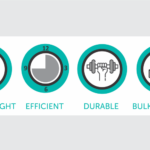"*" indicates required fields
The added value of RFID technology versus barcode

The RFID tag is often referred to as the successor of the barcode. Both are indeed data carriers, but apart from that there are many differences. Let us convince you to choose for the efficiency and sustainability of RFID.
A barcode consists of a pattern of numbers and patterns of lines or squares. Thanks to the collection of these, the type of product can be identified in a unique way. A barcode is read and decoded by a barcode scanner.
RFID technology, on the other hand, uses radio waves to read or send information remotely and wirelessly. An RFID system consists of a tag or label, which is attached to an object or person and on which the unique information is kept. The information is read by an RFID reader and then processed by intelligent software. We also make a distinction between passive tags – which use the signal they receive to activate themselves – and active tags, which have their own power source.
Advantages of RFID
- Very robust thanks to the housing
- No line-of-sight required to read the data
- Tags can be read from a greater distance
- High data capacity
- Unique code per product is possible
- Bulk reading is possible, speeding up data registration
- The data is secure (encrypted data) and rewritable
- RFID tags are difficult to copy and durable in use
Although RFID tags may be more expensive to purchase, thanks to their high data capacity and robust design, they are also much more efficient, accurate and durable than barcodes.
In order to assess the success rate and risks of a specific RFID project, it is crucial to choose the right tag and to test the RFID project thoroughly. For more information on this subject, we refer to our white papers on the importance of tag selection and our Proof of Concept webpage.